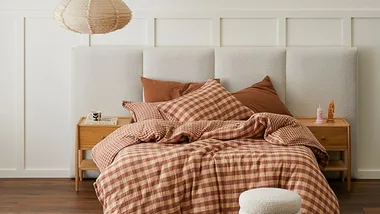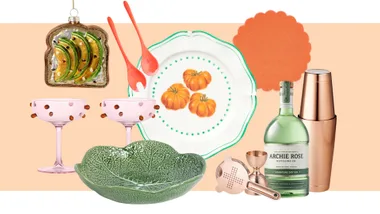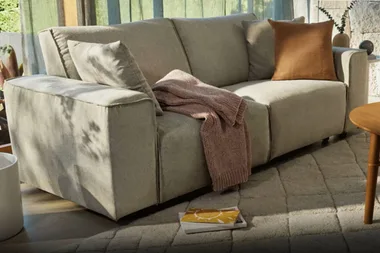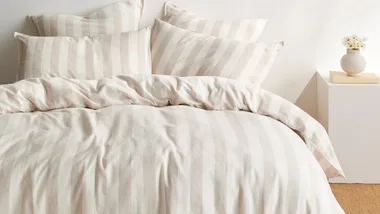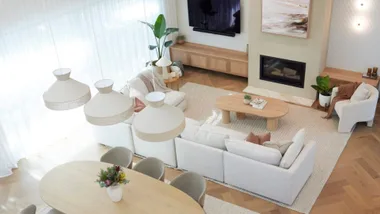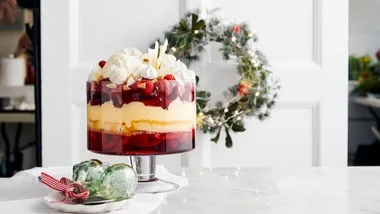Picking the right bathroom vanity or bathroom cabinet can make or break a bathroom makeover or renovation. It’s important that your bathroom vanity design strikes a balance between bathroom storage that caters to all your needs, and an aesthetically pleasing design feature that elevates the space into luxury interior design territory.
“When building or renovating, think of all the items that need to be stored in the bathroom and how accessible you want them to be,” says Luke Harris, property expert at The Property Mentors. “You don’t need to buy off the shelf vanities, often paying a little extra for custom-built cabinetry will give you something unique and may even add that extra bit of luxury. While a vanity unit may not increase the value of your property on its own, A great bathroom vanity idea can contribute to your property being both more liveable, and saleable in the future.”

“In general terms, most people will not pay a premium for something that they can’t really see or feel the benefit of. However, some people will heavily mark down, or devalue, items they view as cheap or nasty,” says Matthew Bateman, co-founder of The Property Mentors. “When it comes to bathroom vanities they are mostly all built in a similar material, such as laminated particleboard, so there’s no use spending too much extra money here. The places where you can get some wow factor are usually going to be on items such as soft-closing draws, the type of vanity benchtop used, such as laminate, porcelain, stone, marble, and additional bling such as the type of basin or tapware you choose.”
“As always, how much you spend will be determined by whether you are renovating for your own enjoyment of the property or to increase the property’s value, and the demands of the target buyer or tenant for the property.”
What are the most popular colours for bathroom vanities and cabinets right now?
Andrea Lucena-Orr is the Colour and Communications Manager at paint brand Dulux, and she says the most popular colours in bathrooms, and for the wider realm of bathroom vanity design, are mostly whites and other neutral colours. “The grey green ‘Spanish Olive’ by Dulux also looks amazing on the bathroom cupboards,” says Andrea. The most popular colours right now are Lexicon – a cool grey-tinted white – in half and quarter strengths; Natural White, which is a warm white; Grey Pail, a grey that errs on the side of blue; and Silkwort, a softer grey.

What should you keep in mind when shopping for a bathroom vanity or cabinet
It’s incredibly important to remember that the bathroom is a workhorse of a space and will have to endure water, spills from medications, makeup or hair products, toothpaste, and countless other life events that take place in the space. When buying or building a bathroom vanity or cabinet, it’s important to choose a bathroom vanity design and material that will cater to your household and lifestyle, as well as your budget.
“Practicality is the key to a successful bathroom vanity idea. Think about things like toothpaste splatters, hair product spills on the shelves and the vanity bench top when selecting the materials and colours for your cabinetry and vanity,” says interior designer Emma Blomfield.
“I recommend always buying the highest quality bathroom vanity you can afford, and don’t splash out on fancy colours; stick to a neutral colour palette, especially if you plan to sell within the next five years.”
For a timeless look, mix materials such as a timber bathroom cabinet with stone bench tops,” says Emma. “However, Hamptons-style is a clear winner for bathroom vanity designs right now, with lots of white on white and splashes of grey. This look is versatile and can evolve with your own personal style over the years, which makes it the perfect choice.”
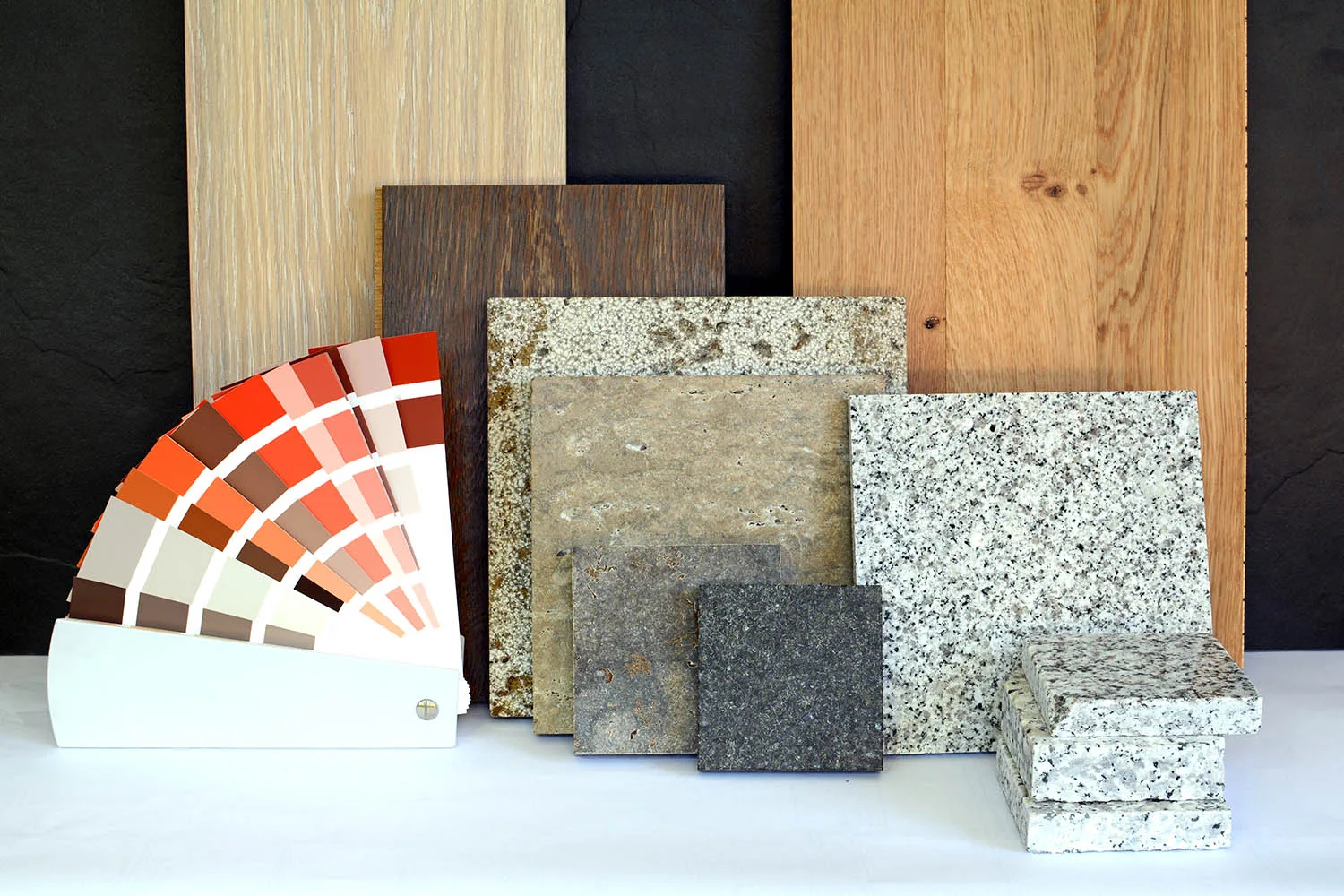
Planning to DIY? Here’s what you need to know
According to Build Australia, the standard vanity height for a bathroom is between 85cm to 90cm, but they can be installed higher if need be. However, should you plan on selling the property in the near future, keep in mind that families with children, or who are short, won’t appreciate a custom-height vanity. Furthermore, this height should be adapted to suit the type of sink you choose for your vanity. A vessel sink that sits flush with the benchtop doesn’t require adjustment, while a stone basin or similar that sits atop the benchtop requires the cabinet to be slightly lowered so hands can be washed comfortably. Hang mirror at eye level, usually between 160-175cm on average.
“Carefully plan where you want the vanity placed, keeping in mind existing plumbing,” says Bostik renovation specialists Mark Menegatti and Adrian Franchina. “If you’re renovating and wanting to save on costs, keeping the vanity where the existing plumbing is saves relocation costs from your plumber. Other things to keep in mind are the flow of the bathroom, and the orientation of the access door to ensure the vanity does not sit in the opening space.”
Mark and Adrian recommend double checking all your bathroom measurements to ensure the drawers and doors on your bathroom cabinet won’t collide with other elements in the bathroom, such as the shower screen, bath, toilet, towel rails or even the entry door. “Choose a bathroom vanity that fits the space well without taking over the area, and that has plenty of storage and style as well as functionality.”
“Some bench tops incorporate the sink into the one material, while others you’ll need to choose a sink that suits your style and requirement.”
Mark and Adrian’s top tips for bathroom vanity design ideas:
- Ensure the design flows and isn’t too crowded, with care given to placement, such as the towel rails within reach of the shower, toilet paper holders in easy reach of the toilet, etc.
- If renovating, consider in your bathroom vanity design if you can keep the vanity, shower and bath in the same position to save on re plumbing costs.
- When choosing your vanity, ensure it has plenty of storage and practical functionality as well as fitting your style.
- Good lighting and ventilation with exhaust fan is a must.
- Ensure convenient mirror placement with lighting over the mirror and bathroom cabinet.
What are the best materials for bathroom cabinetry and vanities?
According to the Bostik DIY specialists, most bathroom cabinets are made from laminated plyboard or MDF, or solid wood. You can then choose from a selection of benchtops, such as stone, marble, glass, timber, fiberglass or porcelain.
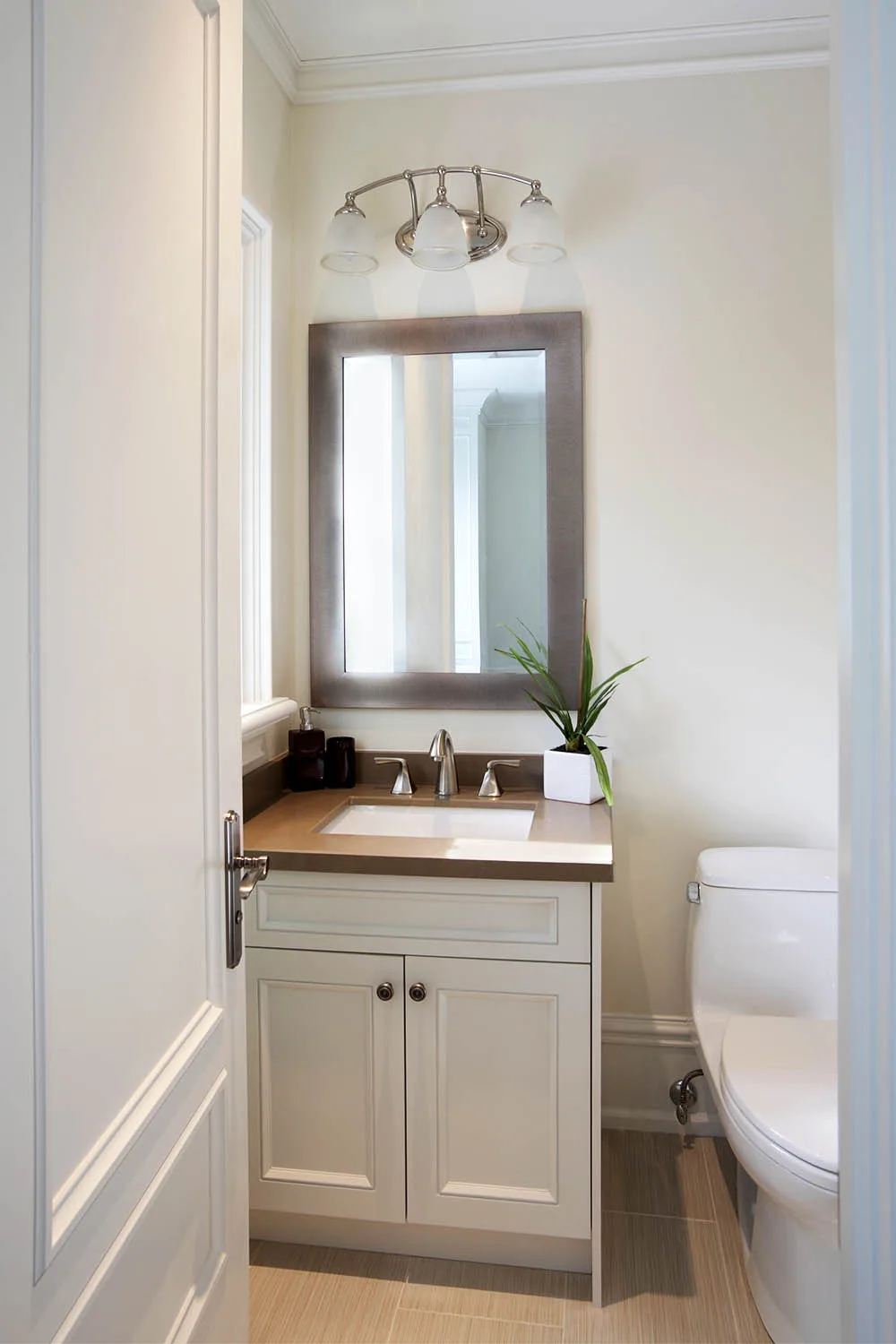
How to care for specialty bathroom vanity bench tops
“Timber bench tops should be varnished to protect them from water staining and rotting, while marble requires extra care and attention,” says Mark and Adrian. “Marble is a soft stone that reacts to acids found in some cleaning and beauty products, and some foods such as vinegar. If any products like this spill on the marble they need to be mopped up straight away to avoid damage.”
The renovation experts also explain that care will need to be taken with hot hair irons and curlers as placing them directly on marble can cause marble to crack. The boys recommend Ceaser stone as it’s a little more robust, however a mild cleaning product should be used.
12 of the best bathroom cabinets and vanities
12. Easy DIY bathroom vanity

One of the easiest ways to make your bathroom look schmick and keep your vanity looking timeless is by choosing a classic colour palettes and layout. Here, a basic laminated chipboard or MDF bathroom cabinet is paired with a laminate benchtop, a statement square sink and chrome tapware ad handles. Keep your tiles white and the accessories black for a chic yet affordable DIY option that can be made from a flatpack or Bunnings bathroom set. Finish with a large, sleek and simple mirror at eye level.
11. Bathroom vanity for a powder room

A powder room does not require the extra storage and space that a main bathroom or ensuite needs as it’s generally a space reserved for guests. With that in mind, a powder room bathroom vanity can be sleek and simple. This particular design pairs a simple white bathroom cabinet with a partly-sunken sink and chrome mixer. The black mirror is a nice contrast against the all-white space, and it draws the eye upwards. A nice feature here is the built-in shelf in the mirror frame, perfect for holding hand soap or other guest necessities.
10. Bathroom vanity with double sink
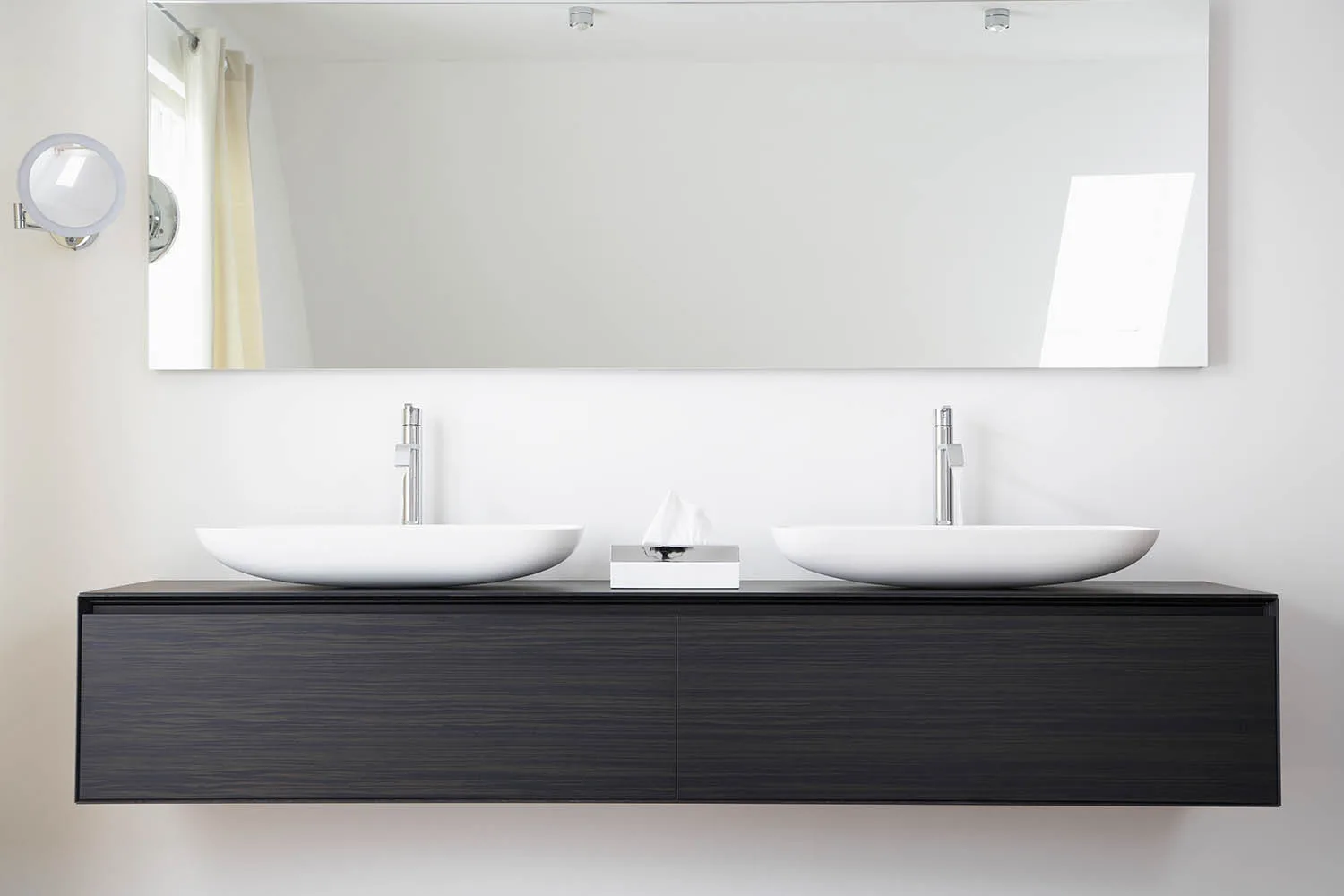
The bathroom vanity with a double sink feature often feels luxurious and high-end, and as you can see here, it doesn’t take a huge investment of money into a large bathroom cabinet or fancy stone bench top to get that air of glamour. Pair a basic floating bathroom vanity with a large mirror of equal length, and keep your sink options sleek and simple for a his-n-hers set up that screams style.
9. Floating bathroom vanity
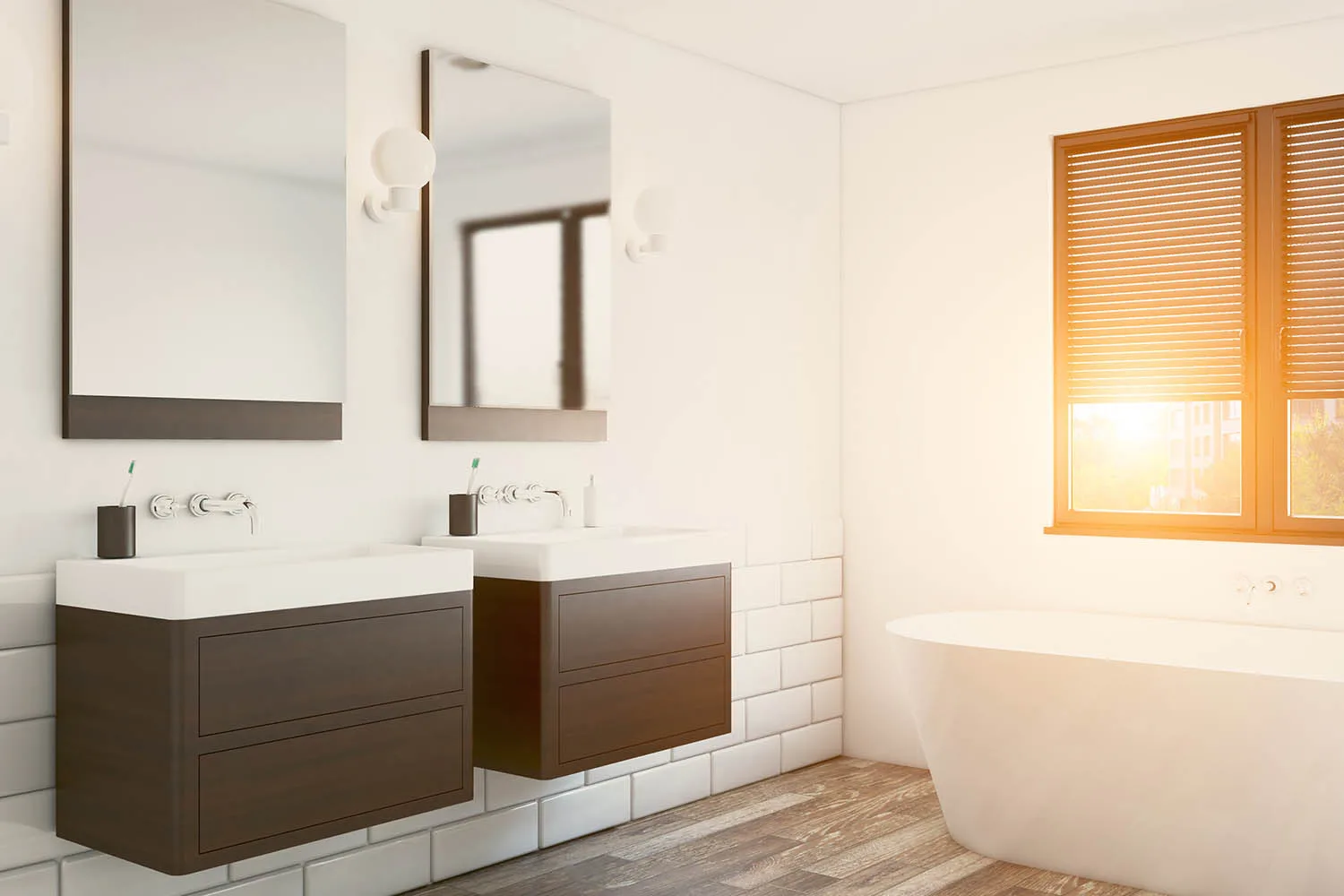
A floating bathroom vanity can be done in many different styles. It can be one large bathroom cabinet installed against the wall, it can be two small bathroom vanities set apart as it is here, or a floating bathroom vanity can be a simple as a single drawer and benchtop in an ensuite, the options are endless. The floating bathroom vanity is a very modern take on bathroom design and as you can see here the double bathroom vanity with individual floating cabinetry can not only be a practical addition to a spacious bathroom, but an aesthetically pleasing one too.
8. Concrete vanity top
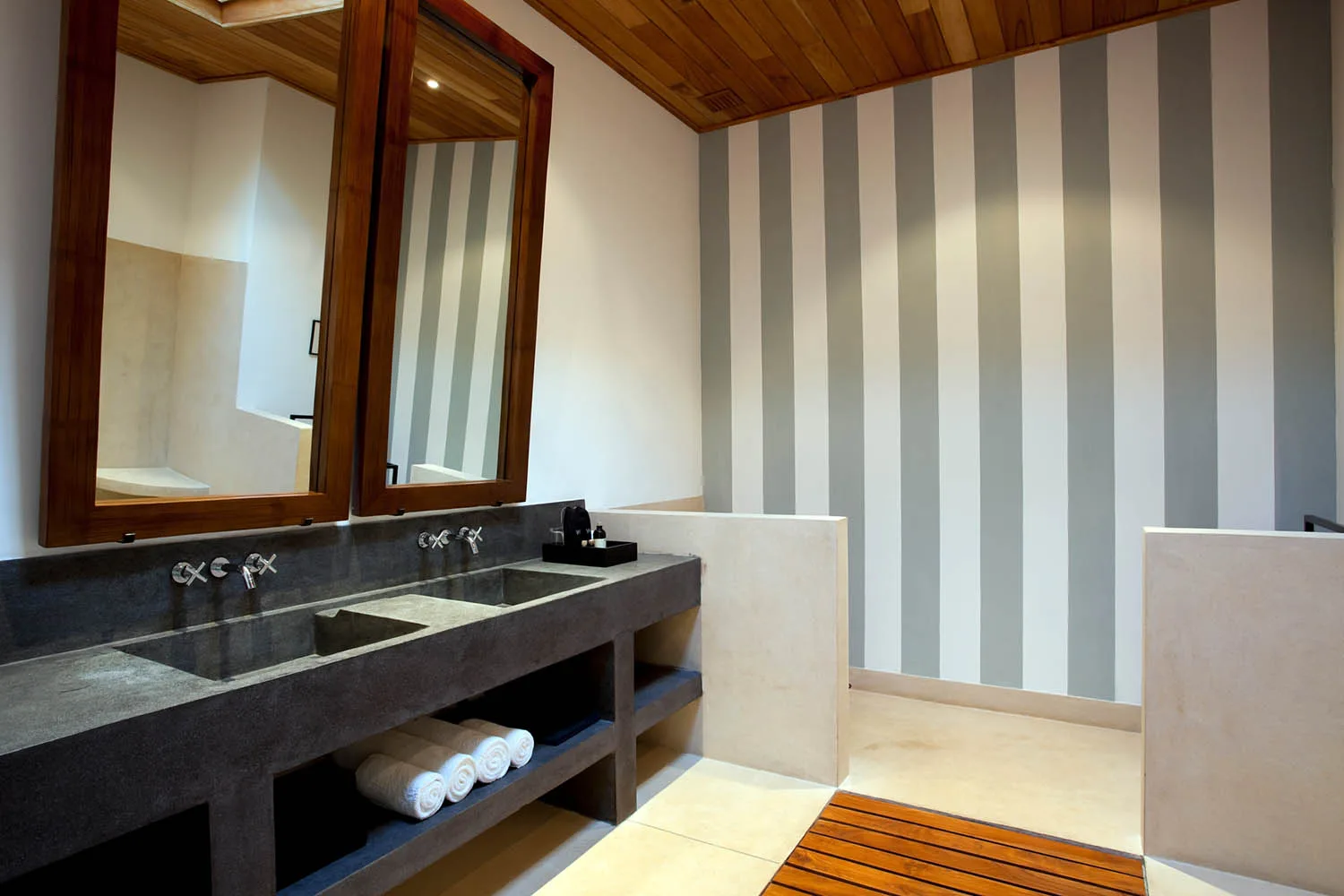
For a bathroom that’s rich in texture nothing goes past a bathroom design idea that incorporates concrete. Here, a concrete vanity top is paired with other natural materials such as stone and timber to create a visually dynamic space that still has a ‘natural’ vibe to it.
7. Luxury bathroom vanity set up
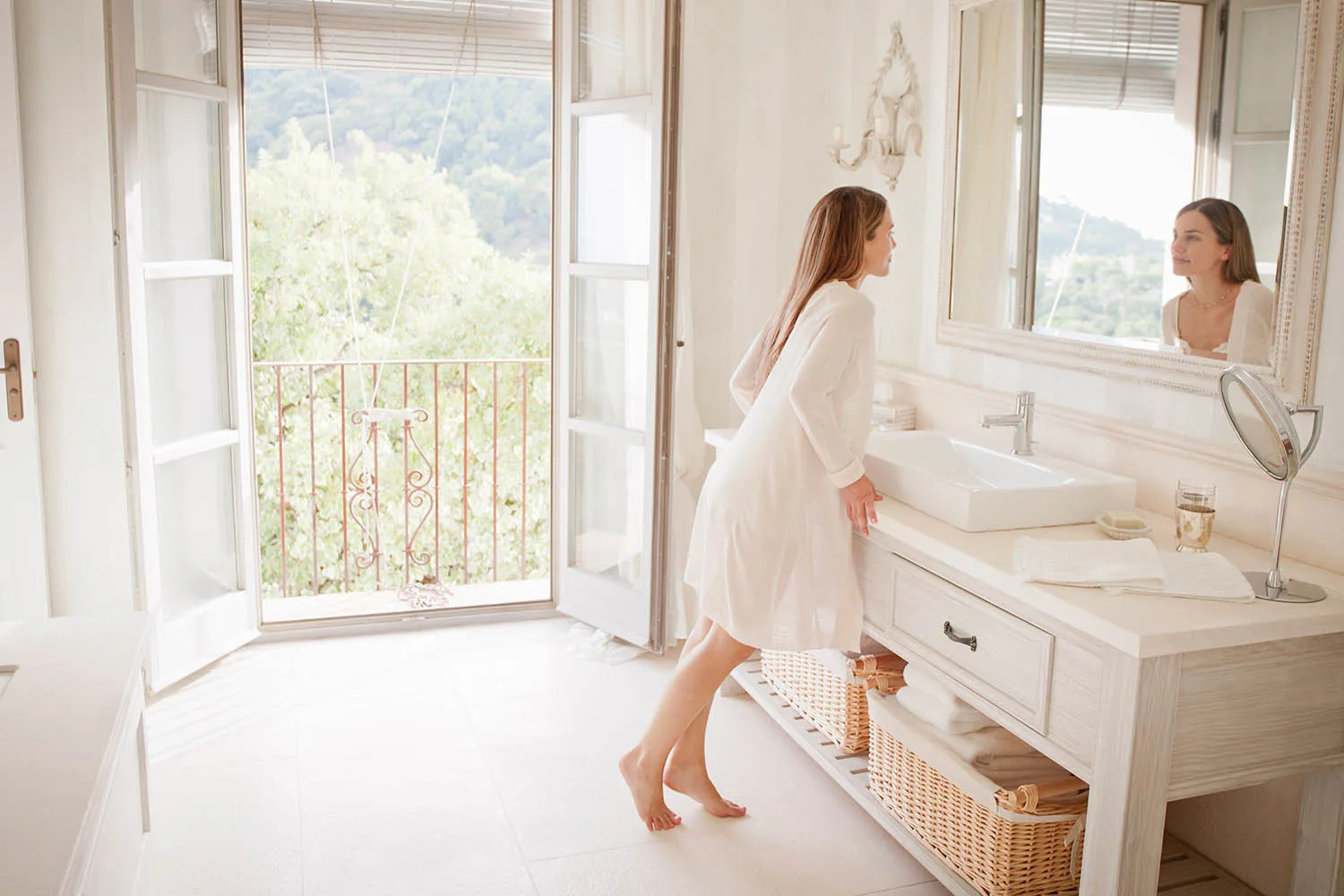
Bathroom design ideas shouldn’t be limited by typical bathroom features such as enclosed cabinetry or laminate sinks and benchtops. Here, a timber piece of furniture has been installed against the wall with open shelving below, and a large porcelain sink is installed atop it. The mirror has a stylised timber frame that ties into the timber vanity, and the overall colour palette of white-washed wood, white tiles and chrome detailing makes this bathroom feel extra luxurious. Extra points for a glamorous wall sconce light.
6. Bathroom cabinet for a master bathroom

Natural materials can be paired with high-tech laminate to create a spacious and luxurious bathroom suitable for use by a family or couple. Pair elements such as concrete tiles, timber, marble and laminate together to get a similar effect that will robust and withstand the test of time.
5. Bathroom cabinet in rustic timber

This bathroom is another example of how rustic pieces of furniture can be repurposed into a bathroom vanity. This set of rustic timber drawers has a marble benchtop and chrome tapware in a traditional style to play up the rustic characteristic of the piece. Finish the look with exaggerated medicine cabinets and wall sconces.
4. Modern bathroom vanity
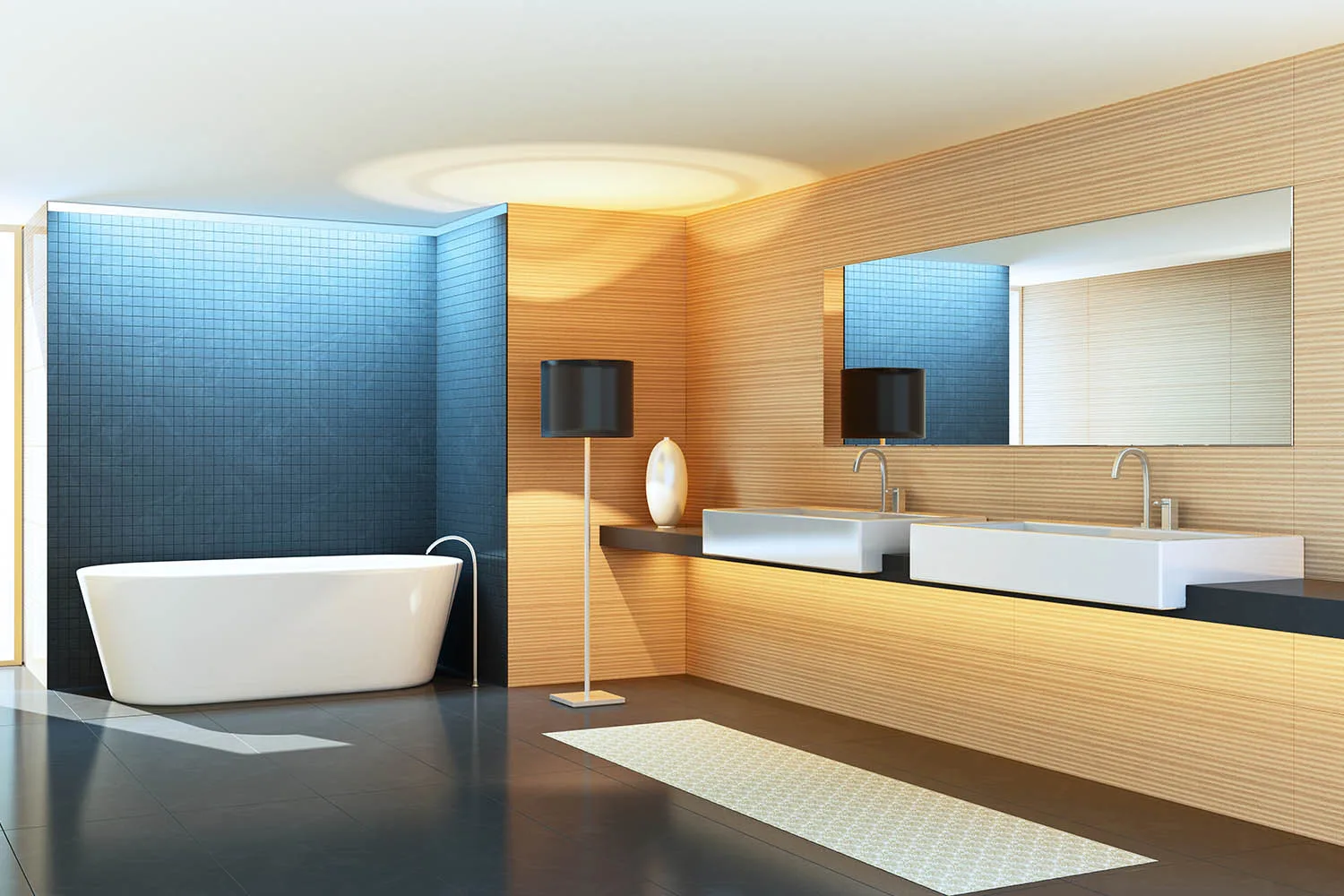
Most modern bathroom vanities are exceptionally minimalistic and sleek. Here, a bathroom vanity with double sinks is set into a stone benchtop with little storage. However, this design could be adapted to suit built-in bathroom cabinets for extra storage and functionality.
3. Bathroom cabinets in bold colours

There’s nothing like a bathroom vanity that pushes boundaries to start a conversation. If you’re considering using bold colours in your bathroom spend some time working out which hues complement each other he most. Here, the oranges a bright pop that appears only in small doses among the dominant colour, which is a muted navy blue on the bathroom vanity and a mottled grey-blue splashback.
2. Small bathroom vanity

Just because your bathroom is small doesn’t mean you need to compromise on style, as you can see here. A dark colour palette makes a bold statement while the small bathroom vanity, toilet, shelving and mirror all line one wall, leaving room for a shower frame on either the opposite wall or at the end of a narrow room. For extra storage, ensure the medicine cabinet has hidden shelving, or extend the small bathroom vanity to the floor.
1. Bathroom cabinetry in white
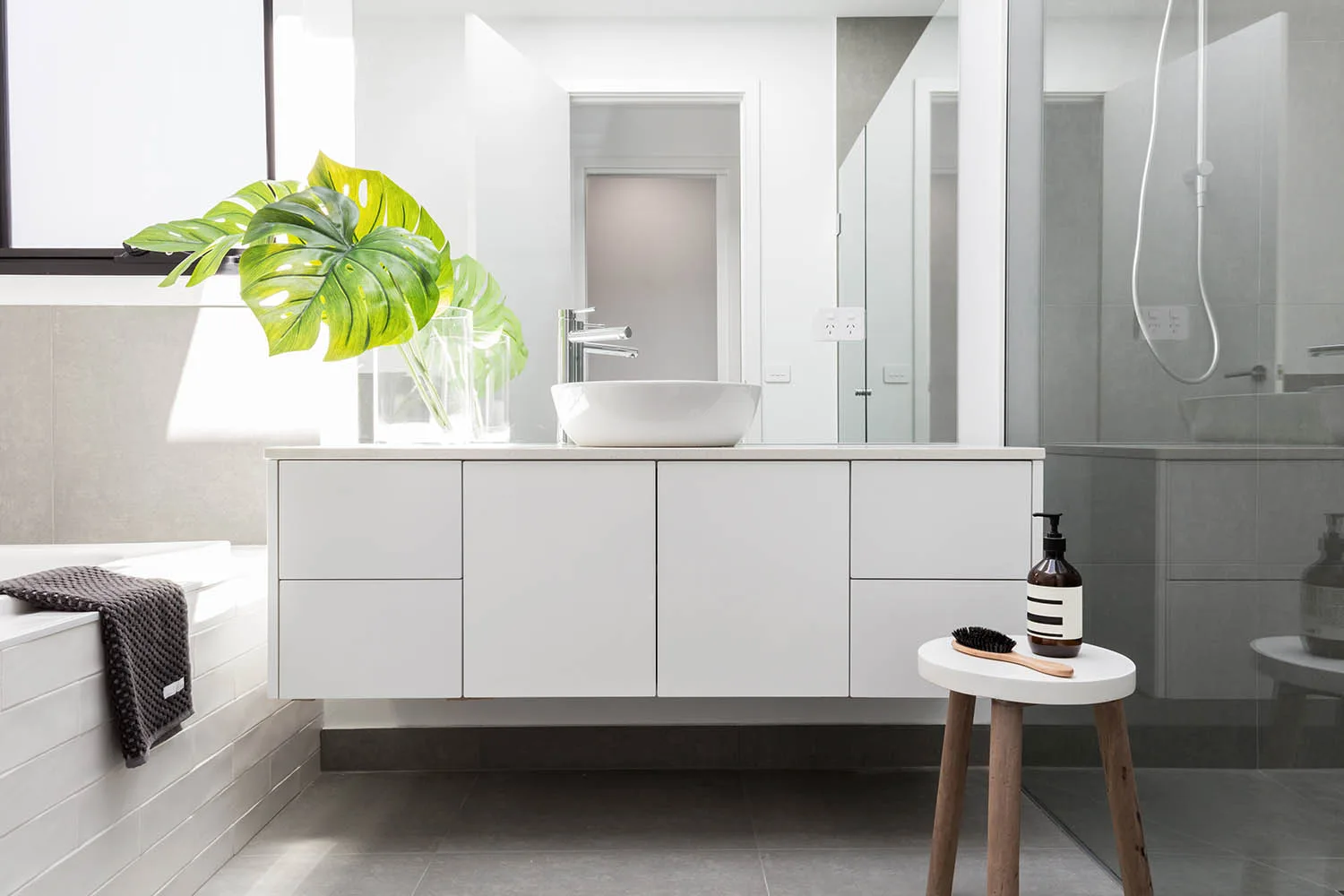
Keeping your bathroom to an all-white palette is an easy way to make it look more expensive than it is. If you’re sticking to white cabinetry, bench top, sink and tiling, incorporate texture into the space by introduced textured tiles in different shapes, greenery via large foliage plants and statement tapware that looks modern and architectural. For an added designer touch opt for a sink that sit above the bench top.

